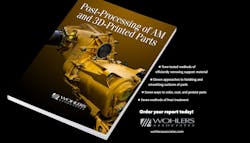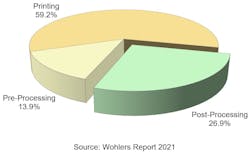According to Wohlers Associates (Fort Collins, CO), organizations involved with additive manufacturing have vast amounts of post-processing knowledge and experience, yet little systematic documentation is available. This has led to countless companies “reinventing the wheel” and spending time and money unnecessarily to complete jobs. The methods and techniques described in this report can reduce trial-and-error that so many organizations use.
Post-processing is one of three major phases of producing 3D-printed parts. According to research conducted for Wohlers Report 2021, nearly 27% of the cost of producing additively manufactured parts comes from post-processing.Now a special Wohlers report, titled “Post-Processing of AM and 3D-Printed Parts,” details many time-consuming and often-expensive steps in post-processing parts made by additive manufacturing. Examples include support material removal, the finishing of surfaces, coloring and coating, and heat treatment. The report advises consideration of the entire end-to-end workflow. Bottlenecks are a challenge, especially when scaling into production quantities. The post-processing steps for metal powder-bed fusion (PBF) include the removal of powder, thermal stress relief, and the separation of parts and support material from the build plate. They also include the removal of supports from parts, media blasting, and machining and grinding. Some parts may require hot isotropic pressing, additional heat treatment, anodizing, and inspection. If post-processing is not scaled and streamlined accordingly, bottlenecks will occur, especially with large quantities.
Design for additive manufacturing is a key to reducing time and costs associated with post-processing. For example, orient metal PBF parts so the faces to be machined are facing downward. These down-facing surfaces will be rough due to the support material, so use this to your advantage.
For more on this report, please visit wohlersassociates.com.
For 26 years, Wohlers Associates has published the Wohlers Report, a publication that many refer to as the “bible” of 3D printing.


